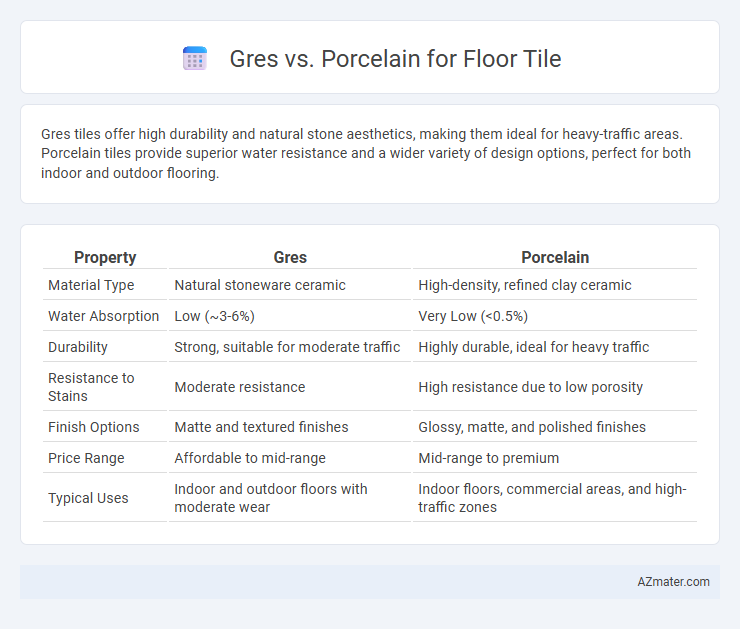Gres tiles offer high durability and natural stone aesthetics, making them ideal for heavy-traffic areas. Porcelain tiles provide superior water resistance and a wider variety of design options, perfect for both indoor and outdoor flooring.
Table of Comparison
| Property | Gres | Porcelain |
|---|---|---|
| Material Type | Natural stoneware ceramic | High-density, refined clay ceramic |
| Water Absorption | Low (~3-6%) | Very Low (<0.5%) |
| Durability | Strong, suitable for moderate traffic | Highly durable, ideal for heavy traffic |
| Resistance to Stains | Moderate resistance | High resistance due to low porosity |
| Finish Options | Matte and textured finishes | Glossy, matte, and polished finishes |
| Price Range | Affordable to mid-range | Mid-range to premium |
| Typical Uses | Indoor and outdoor floors with moderate wear | Indoor floors, commercial areas, and high-traffic zones |
Introduction to Gres and Porcelain Floor Tiles
Gres floor tiles, also known as porcelain stoneware, are highly dense, low-porosity tiles made from refined clays and fired at high temperatures, offering exceptional durability and resistance to moisture. Porcelain floor tiles, a subtype of gres tiles, have a fine, uniform composition that makes them ideal for both indoor and outdoor applications due to their strength and minimal water absorption rates below 0.5%. These characteristics make gres and porcelain tiles popular choices for homeowners seeking long-lasting, low-maintenance flooring solutions.
Composition and Manufacturing Differences
Gres floor tiles, typically made from natural clay mixed with quartz and feldspar, undergo a single firing process at high temperatures, resulting in a dense and durable surface. Porcelain tiles, a subset of gres tiles, feature a finer, more refined composition with added kaolin and rarely contain impurities, fired under even higher temperatures and pressures to achieve superior hardness and low porosity. This manufacturing distinction leads porcelain tiles to offer enhanced resistance to moisture, stains, and wear compared to standard gres tiles, making them ideal for high-traffic areas and wet environments.
Durability and Strength Comparison
Porcelain tiles offer superior durability and strength compared to gres tiles due to their denser composition and lower water absorption rate, typically below 0.5%. Gres tiles, while strong and suitable for high-traffic areas, generally have a higher porosity, making them less resistant to heavy impact and moisture over time. Porcelain's vitrified surface enhances resistance to scratches, stains, and frost, making it ideal for both indoor and outdoor flooring applications requiring long-lasting performance.
Water Resistance and Porosity
Porcelain tiles exhibit superior water resistance due to their low porosity, typically less than 0.5%, making them highly suitable for moisture-prone areas like bathrooms and kitchens. Gres tiles, while also durable, have a slightly higher porosity level, which can lead to increased water absorption and potential damage over time if not properly sealed. The denser composition of porcelain tiles ensures better resistance to stains and liquids, enhancing their longevity in environments with frequent exposure to water.
Aesthetic Options and Design Versatility
Gres and porcelain tiles both offer extensive aesthetic options, with gres providing rich natural stone and earthy textures ideal for rustic or traditional designs, while porcelain tiles excel in versatility with a wide range of colors, patterns, and finishes including polished, matte, and glazed surfaces. Porcelain's ability to mimic natural materials like wood, marble, and concrete allows for seamless integration into modern, minimalist, or contemporary interiors. Gres tiles are typically thicker and heavier, lending a rugged, authentic look, whereas porcelain tiles offer precise cuts and uniformity, perfect for intricate patterns and creative layouts.
Installation Process and Complexity
Porcelain tiles require precise cutting and specialized tools due to their density and hardness, making installation more complex compared to gres tiles. Gres tiles, being slightly softer and more porous, allow for easier handling and cutting, reducing installation time and labor costs. Both materials demand proper subfloor preparation and skilled labor to ensure a durable, level finish but porcelain's increased fragility during cutting elevates overall installation complexity.
Maintenance and Cleaning Requirements
Gres tiles are known for their durability and resistance to stains, making maintenance straightforward with regular sweeping and mopping using mild detergents. Porcelain tiles offer a non-porous surface that prevents water absorption and resists mold, requiring minimal sealing and easy cleaning with standard household cleaners. Both materials boast low upkeep, but porcelain's denser composition often leads to longer-lasting pristine appearances in high-traffic or moisture-prone areas.
Cost Analysis: Gres vs Porcelain
Gres floor tiles typically cost less than porcelain, offering a budget-friendly option without sacrificing strength and durability. Porcelain tiles, while higher in price, provide superior water resistance and a denser composition, justifying the investment for high-traffic or moisture-prone areas. Comparing both materials, gres offers cost-effective versatility, whereas porcelain demands a premium upfront cost but delivers long-term value through enhanced performance and longevity.
Best Applications for Gres and Porcelain Tiles
Gres tiles, known for their durability and low porosity, are ideal for high-traffic commercial areas and outdoor applications where resistance to wear and weather is crucial. Porcelain tiles, with their dense composition and superior water resistance, excel in residential bathrooms, kitchens, and spaces prone to moisture exposure. Both materials offer versatility, but gres is preferred for heavy-duty flooring, while porcelain provides a refined aesthetic suited for indoor environments.
Conclusion: Choosing the Right Tile for Your Floor
Porcelain tiles offer superior durability, water resistance, and a wide range of design options, making them ideal for high-traffic and moisture-prone areas. Gres tiles, known for their strength and aesthetic variety, are suitable for both indoor and outdoor spaces, providing a cost-effective alternative. Selecting the right tile depends on your specific needs for durability, maintenance, and style preferences to ensure long-term satisfaction with your flooring.

Infographic: Gres vs Porcelain for Floor Tile
 azmater.com
azmater.com